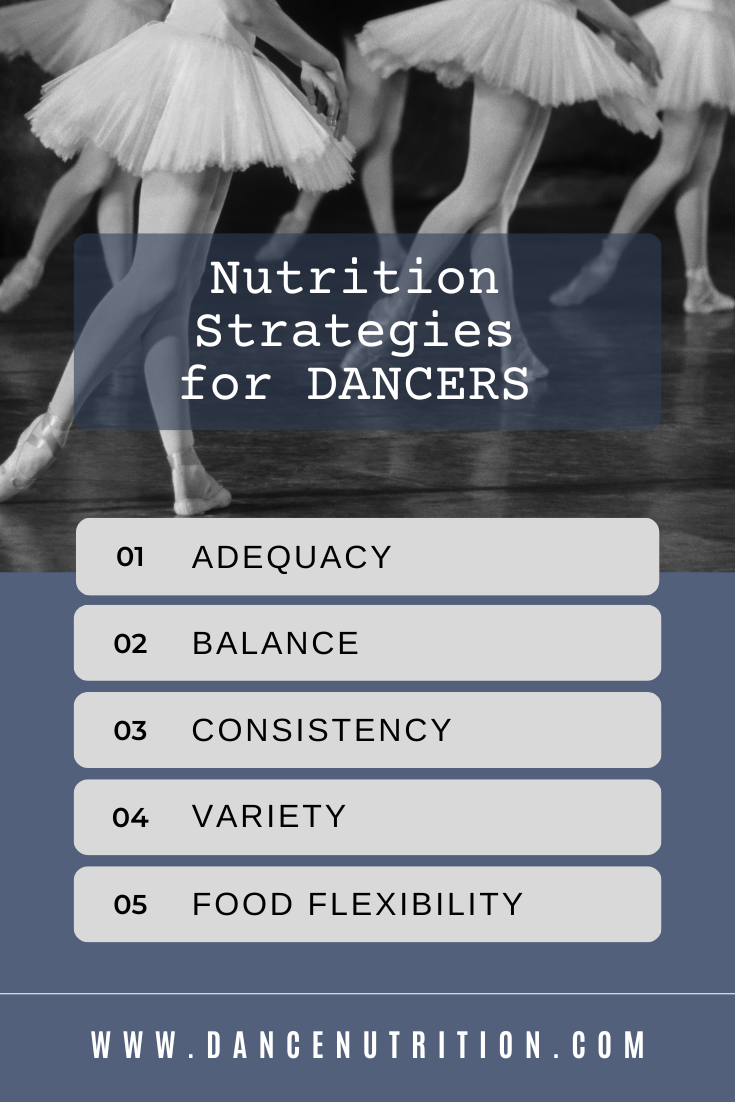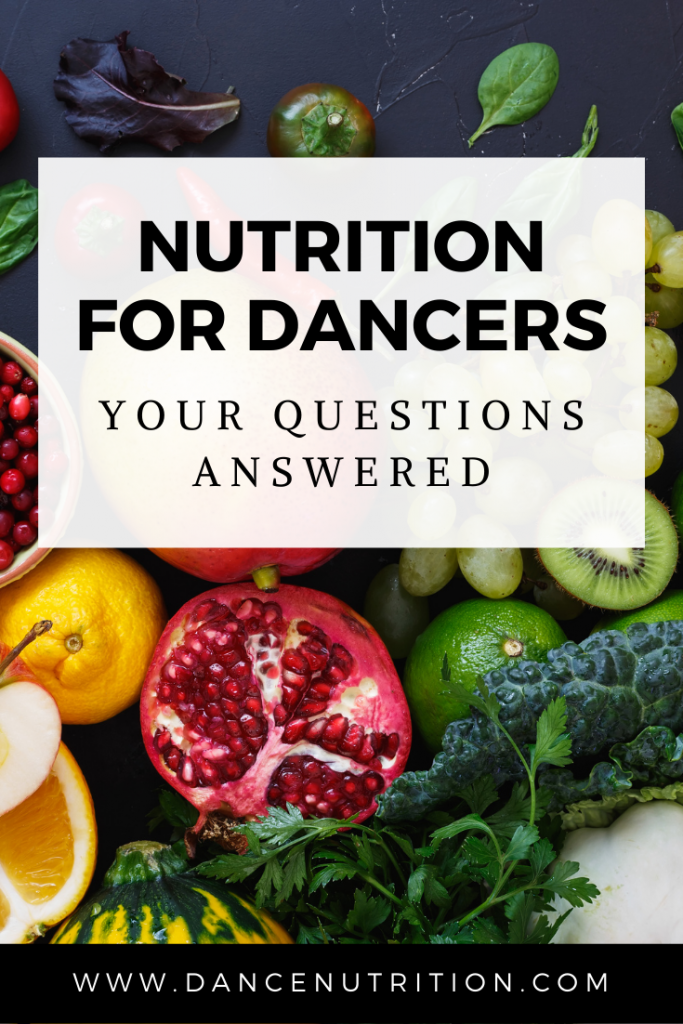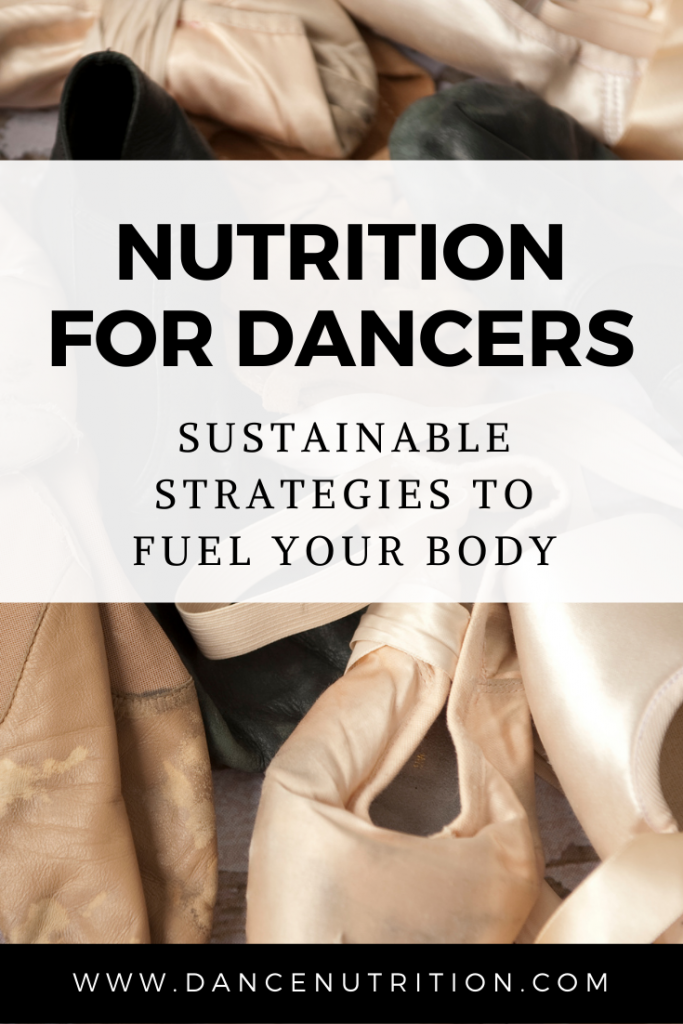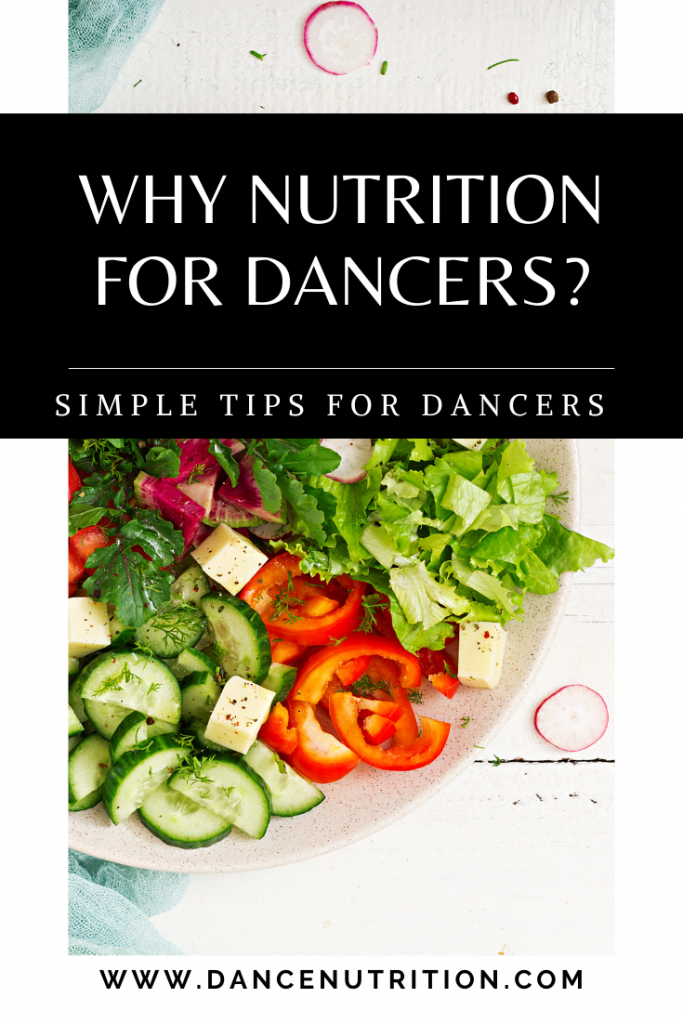When compared to the general population, dancers have a three times higher risk of suffering from an eating disorder. Restrictive “clean” eating food plans and nutrition misinformation are often to blame, impeding a dancer’s ability to fuel for performance. In attempts to eat “right,” dancers miss the mark on eating enough. As a dietitian for dancers, I’ve previously discussed the benefits of nutrition education; this article will provide you with the fundamentals to get started.
Your Fuel Needs as a Dancer
There are five fundamentals to consider when building your dancer fuel plan:
- Nutritional Adequacy (are you eating enough?)
- Macronutrient Balance
- Mealtime Consistency
- Food Variety
- Food Flexibility
These five values encompass The Healthy Dancer® Functional Fuel— a guided practice designed to optimize a dancer’s performance sustainably.

Good nutrition for dancers starts with The Healthy Dancer® Functional Fuel
#1: Nutritional Adequacy
Understanding your nutritional needs as a dancer begins with identifying whether you’re fueling adequately. Dancers often feel that to do this, behaviors like calorie counting or “portion control” are the answer. However, these behaviors perpetuate restrictive eating and drive dancers further from their abilities to truly harness body attunement.
Nutritional adequacy requires a radical dismantling of food and body beliefs that unfortunately saturate our studios. This includes food and mealtime fears— calories, carbs, fat, and various food groups deemed “unhealthy” are examples. Here are three articles to get you started:
#2: Macronutrient Balance: what should dancers eat?
Dancers need a diet that is balanced among nutrients— the macronutrients carbohydrates, fat, and protein, along with the micronutrients (vitamins and minerals). A dancer’s fuel mix embodies a single meal or snack that includes sources of complex carbohydrates, proteins, and fats. Carbohydrates are a preferred energy source for the body, providing the necessary sugars to fuel your muscles and brain. It’s recommended that carbohydrates make up at least 55-60% of a dancer’s diet with up to 65% for more intense training schedules (learn more about carbohydrates here). Carb-rich foods, particularly plant-based options like legumes, nuts, seeds, whole grains, veggies, and fruit are rich in fiber, supporting a steady flow of energy that can be maintained for longer. Here’s an article that uncovers the role of fiber in a dancer’s diet.
The next addition to your fuel mix is protein. Protein helps to repair and rebuild torn muscles (a normal response from intense dancing). Protein-rich foods include dairy and dairy alternatives, eggs, legumes, beans, ancient grains, and pseudo-cereals (like quinoa) are examples. Amino acids are the building blocks of protein and ultimately, anabolic growth. Dancers will benefit from a unique balance of amino acids, and with the help of a Registered Dietitian Nutritionist, can identify how to best meet those needs with food (more on this here).
The final macronutrient of your fuel mix is fat. Adding fat to your meal enhances the absorption of fat-soluble vitamins A, D, E, and K. Fat also supports bone health, promotes hormonal functioning, and keeps you satisfied. Fats from sources like avocadoes, nuts, and oils heal your body and reduce the natural inflammation experienced in dance. Flax, chia, nuts (especially walnuts), green leafy veggies, and fortified eggs are rich in omega-3 fats and tend to be more budget-friendly. Animal fats like those found in butter, whole-milk dairy, cheese, meat, and eggs can help construct satisfying meals and should not be feared. Click here to learn more about the myths and facts of fat in a dancer’s diet.
#3: Mealtime Consistency: practical applications
You’ll want to aim for this dancer’s fuel mix multiple times throughout your day— 3 meals and 2 snacks are a great starting point. Avoid time gaps longer than 3-4 hours between meals, and if you’re struggling with diminished hunger cues, map a flexible eating schedule to support proactive fueling efforts. This is especially important since hunger cues can naturally diminish during a busy dancer’s day (read more about this here).
#4: Food Variety
A varied diet will help dancers access a spectrum of nutrients. Dietary patterns over time matter, but as discussed in this article, the three most common barriers to variety at mealtimes are time, money, and restrictive eating patterns. As a dietitian, I encourage dancers to refrain from a “now or never” mindset. Rather, utilize an inclusive food approach, like the one outlined in The Healthy Dancer®. Here are examples:
- Add a handful of whole grain cereal or pretzels to a trail mix.
- Create a grain bowl using wild rice or cooked quinoa as your base. Mix in veggies of your liking and top with grilled chicken. Dress with a tangy vinaigrette.
- Top your favorite yogurt with chopped nuts and sprinkle with flax and chia.
- Spread mashed avocado on whole-grain bread and top with slices of egg.
#5: Food Flexibility
In addition to nutritional adequacy, balance, consistency, and variety is food flexibility. Your meal plan must allow for fluidity. For dancers, a supportive relationship with food incorporates nutrient-dense options, like nuts, fruit, and whole grains while making infinite room for unapologetic enjoyments like fun foods! Loosening the reigns of mealtime rigidity is key and granting yourself full permission to enjoy all foods is the goal.
Nutrition challenges for dancers
What foods should dancers avoid?
Unfortunately, lots of nutrition misinformation circulates the dance world— messages that dictate what dancers “should” and “shouldn’t” eat, along with unsupportive food and body beliefs. Restrictive eating— whether the amount of food or the type of food leads dancers to guilt, shame, fear, and isolation. Low-calorie dieting also compromises a dancer’s energy availability, leading to nutritional inadequacies of important micronutrients like calcium, vitamin D, B12, zinc, iron, and vitamin K. The bottom line? It is rare for food avoidance to be recommended unless a medically-diagnosed allergy exists.
Dancers can learn how to decipher food preferences from food rules (here’s an article that teaches you how). Consider food preferences as a personal drive to eat. Food is culture. Food is fun. Food is social. Food is life. The more we restrict our favorite foods, the more inclined we are to enter a binge- and restrict cycle. Be wary of “light” alternatives as these may leave you unsatisfied. Cauliflower pizza is trendy, but if you’re truly craving pizza, enjoy it. You’ll feel more satisfied in the long run. Removing the moral hierarchy behind your food choices is critical, but can be hard. Here is an article that teaches dancers how to utilize food neutrality throughout their meal and snack choices.
Are calorie deficits helpful?
A calorie deficit results from a calorically insufficient diet that fails to meet a dancer’s physical energy needs. Recognize that as a dancer, your energy needs include calories burned during your activity and the calories required for basic metabolic functioning. Prolonged calorie deficits increase the risk of Relative Energy Deficiency in Sport (or RES-S). RED-S— a syndrome of metabolic consequences that sacrifices physical strength, bone health, and even emotional well-being. Here’s an article that dives deeper into the impact of RED-s on dancer health.
Dancers: access nutrition advice from qualified sources
Anyone can consider themselves an “expert” in nutrition. However, not all “experts” are licensed to provide adequate nutrition information. This is especially true for a population highly vulnerable to the development of disordered eating behaviors. Registered Dietitian Nutritionists (RDNs) are a dancer’s ideal source for nutrition information. Similar to the rigorous training required of a dancer, Registered Dietitian Nutritionists must complete over five years of clinical training in medical nutrition therapy and nutrition research. This unique background enables dietitians to translate scientific jargon into accessible information.
Because dietitians must maintain professional licensure, continuing education is required throughout their professional practice. Since nutrition is an evolving science, this continued education ensures that dietitians remain up-to-date on nutrition research. Such training sets dietitians apart from nutritionists and health coaches. Be wary: if you are instructed to count calories, track macros, and keep concise meal logs, then you’ll want to reassess and consider working with a dietitian for dancers.
Nutrition for Dancers: Start TODAY
The Healthy Dancer® embodies personalized nutrition to support your food and body goals. Considering your likes, dislikes, and food preferences, we work together to construct a practical and realistic plan for your busy schedule. Throughout this work, you discover how food makes you feel. You’ll begin to assess your energy levels in a class. You’ll become attuned to the various systems of your body including your hormone health and digestive health. Through this work, The Healthy Dancer® prioritizes a supportive relationship with food.
A Dancer’s Complete Guide to Intuitive Eating is a good place to start. Dancers can utilize the principles of gentle nutrition in a non-obsessive way to build a proactive approach to fueling for performance. And for the dancer well into their journey of healing their relationships with food and ready to sharpen their skills in nutrition for a successful dance career, sign up for Nourish The Healthy Dancer®. This is a series of self-study courses designed to support the sustainable lifestyle and ongoing journey of The Healthy Dancer®. Available options include:
- Nutrition Without Obsession (Gentle Nutrition) and Performance Nutrition. Learn more here.
- Reclaim Emotional Eating. Learn more here.
- Build Body Confidence through appreciation, neutrality, and respect Learn more here.
You can also dive deeper into these 5 fundamentals in The Healthy Dancer® Functional Fuel Challenge. This is a FREE opportunity that will run annually, every October. Click here to register.





